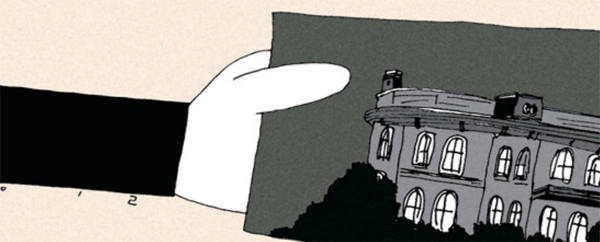A building recalls colonial shame

The Korean Cultural Heritage Administration’s research group showed off the repurchased Korean legation in Washington on Wednesday, exactly 102 years after Japan annexed Korea by force. Thankfully, the interior of the legation building remains close to its original form. The official title of the embassy was the Legation of the Great Korean Empire to Washington. It may have been less tragic if it did not have “great” in the name of the country. The reference to a country on the verge of collapse as “great” amplifies the desperation and sense of crisis of that time.
Senior journalist Hong In-geun, former chief editor of the Dong-A Ilbo and a researcher at the International Center for Korean Studies, translated the records of the Japanese Foreign Ministry and published “Overseas Legations of the Great Korean Empire.” According to Hong’s research, the Japanese empire started political maneuvering to close down overseas missions of the so-called Great Korean Empire on Sept. 6, 1904. Konsuke Hayashi, the Japanese minister in Seoul, sent a lengthy confidential letter to Foreign Minister Jutaro Komura proposing to close down Korea’s overseas legations, starting with recalling its diplomats.
They planned to bring the diplomats back by offering vacations, and then not redispatching them or appointing any successors. The Japanese legations would take over Korea’s diplomatic affairs, and the Korean missions would remain closed. The letter contains provoking and upsetting expressions. “The Korean envoys and officials were dispatched to the countries with diplomatic ties out of the Korean emperor’s vanity, and they are useless, with no missions or international operations.” They treated the diplomats of the Great Korean Empire as useless products of Emperor Gojong’s vanity.
Five months later on Feb. 22, 1905, Japan officially proposed the plan to bring back the diplomats of the Great Korean Empire. Hayashi met with Emperor Gojong and demanded he summon the Korean envoys. While Gojong agreed with the plan in general, he requested the Korean minister to Japan be kept in place in consideration for Korea-Japan relations. Hayashi flatly turned the idea down, calling the measure unnecessary. After the Eulsa Treaty of 1905, through which Japan deprived Korea of diplomatic sovereignty, was signed on Nov. 17, the diplomatic recall unfolded rapidly.
Emperor Gojong paid $25,000 out of his own pocket for the embassy building in Washington, but in 1910, the building was transferred to Japan. It paid Korea $5.
If we forget the painful lessons of history, tragedies may be repeated at any time. Do you recall what happened on Feb. 22, 1905, when Emperor Gojong pleaded to keep the Korean minister to Japan? It was the very day when Japan’s Shimane Prefecture quietly incorporated Dokdo as Japanese territory.
*The author is an editorial writer of the JoongAng Ilbo.
By Noh Jae-hyun
경술국치일인 그제(현지시간) 미국 워싱턴의 옛 주미 한국대사관 내부가 우리 문화재청 조사단에 공개됐다. 망국 102년 만이다. 건물 내부구조가 거의 원형 그대로라니 안도와 함께 온갖 감회가 밀려든다. 대조선주차(大朝鮮駐箚) 미국화성돈공사관. 차라리 국호 앞에 대(大)자가 없었더라면 조금이라도 비감(悲感)이 덜했을 것이다. 망해 가던 나라 앞에 ‘큰 대’자가 붙으니 그 불균형과 애처로움이 몇 배나 증폭되는 느낌이다. 지금의 ‘대’한민국도 이름에 걸맞은 실력과 지혜가 따르지 않으면 언제든 한순간에 허명(虛名)으로 전락할 수 있다는 역사의 교훈을 뼈저리게 실감한다. 원로 언론인 홍인근(77·전 동아일보 편집국장) 국제한국연구원 연구위원이 일본 외무성 기록을 번역해 이달 15일 펴낸 『대한제국의 해외공관』에 따르면 일제가 대한제국 해외공관 폐쇄공작을 벌이기 시작한 것은 1904년 9월 6일이었다. 주한 일본공사 하야시 곤스케는 이날 외상 고무라 주타로에게 보낸 장문의 기밀문서에서 “재외한국공관을 폐쇄해야 하며, 그 전 단계로 외교관들을 소환하자”고 건의했다. 외교관들에게 휴가를 주는 형식으로 귀국시킨 뒤 재파견이나 후임자 파견을 하지 않으며, 외교업무는 일본공관이 대신 처리하면 자연스럽게 폐쇄될 것이라는 내용이다. 전문에는 어쩔 수 없이 부아가 치미는 표현이 있다. ‘여러 조약국에 주차하고 있는 한국 사신 및 그 속료는 한제(韓帝)의 허영(虛榮)정책에 따라 파견된 것으로 임국(任國)에서 시행해야 할 사명이나 국제사무가 전혀 없는 단지 무용의 장물(長物)일 뿐’이라는 대목이다. 대한제국 외교관들은 고종의 허영심 때문에 해외에 파견됐을 뿐이지 실제로는 쓸모 없는 물건이라는 뜻이다. 일본이 대한제국 외교관 소환공작을 한국정부에 공식 제기한 것은 5개월 후인 1905년 2월 22일이었다. 하야시 공사는 이날 고종 황제를 만나 한국 사신들을 소환하자고 요구했다. 고종은 대체로 동의하면서도 “한·일 관계를 고려해 주일공사는 계속 남겨두면 좋겠다”고 부탁했다. 하야시의 대답은 싸늘했다. “그럴 필요 없습니다.” 1905년 11월 17일 을사늑약(을사조약) 체결을 계기로 재외공관원 소환은 급물살을 탔다. 일제의 선소환·후폐쇄 방침은 노골적인 선폐쇄·후소환 방침으로 바뀌었다. 고종이 2만5000달러에 구입했던 워싱턴공사관 건물도 1910년 일제에 빼앗겼다. 우리가 최근 350만 달러를 들여 되찾은 빅토리아풍 건물이다. 뼈아픈 역사의 교훈을 잊으면 언제든 비극이 되풀이될 수 있다. 고종이 “주일공사라도 남겨 달라”고 애원하다 거절당한 1905년 2월 22일이 어떤 날인지 혹시 기억하시는지. 일제가 독도를 자기네 땅이라고 대한제국 몰래 시마네현 고시를 한 바로 그날이다. 노재현 논설위원·문화전문기자










with the Korea JoongAng Daily
To write comments, please log in to one of the accounts.
Standards Board Policy (0/250자)